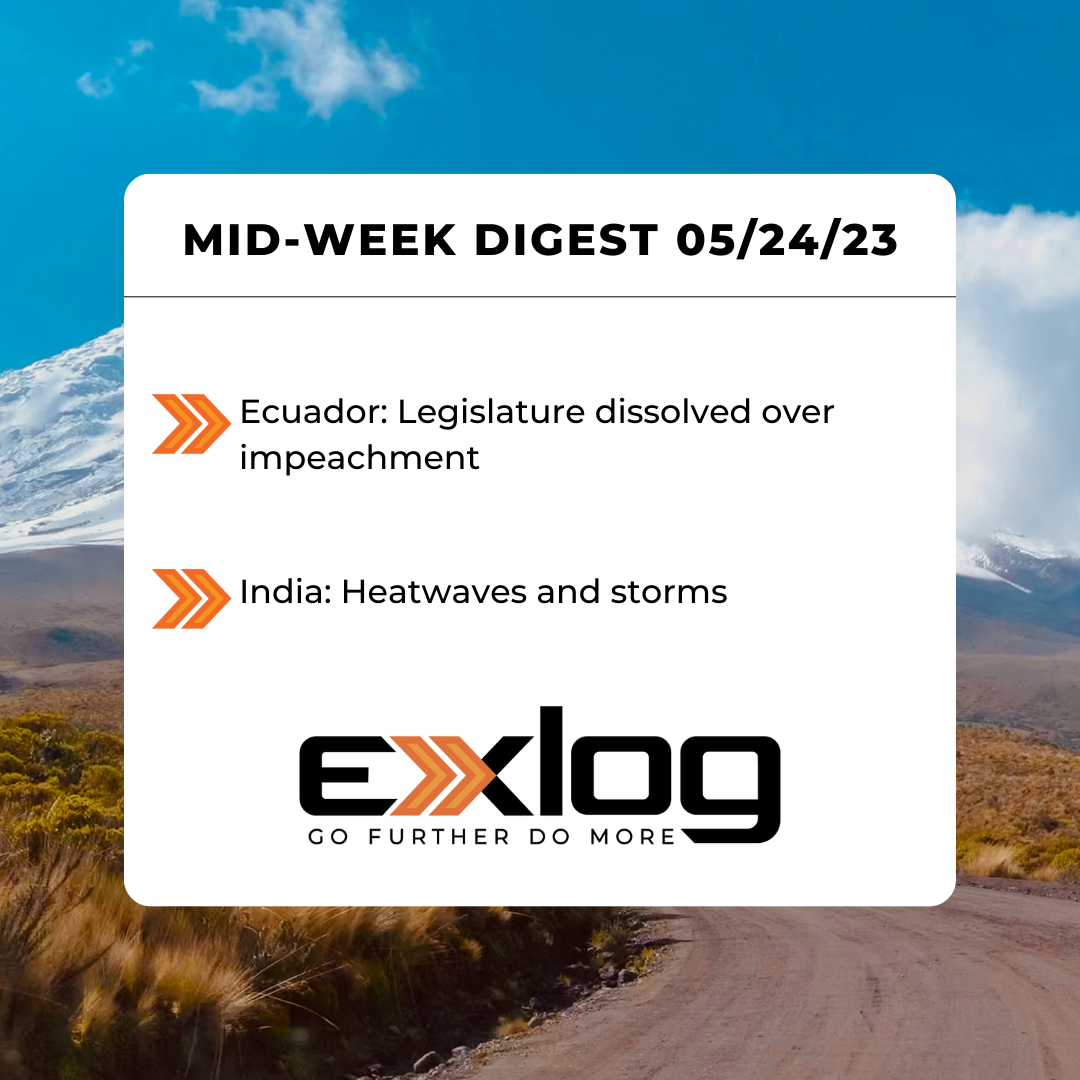Legislature dissolved over impeachment in Ecuador and heatwaves and storms in India
Ecuador: President dissolves legislature, prompting snap elections
Ecuador’s President Guillermo Lasso dissolved the opposition-controlled National Assembly on May 17 amid an impeachment trial, triggering snap legislative and presidential elections and fueling concerns of unrest. Lasso’s move came ahead of a vote to remove him from office over corruption linked to the energy industry – accusations the president has denied. Lasso invoked Article 148 of the Constitution – known as the muerte cruzada (“two-way death”) provision – which allows for both legislative and presidential elections ahead of the regular schedule. Lasso will govern by decree until the snap vote planned for Aug. 20. Those elected to power in the Aug. 20 vote will only remain in office until the regularly scheduled elections slated to take place in 2025. Lasso can run in the snap elections, although he indicated in an interview with an international media outlet that he did not intend to declare his candidacy. Opposition politicians challenged the legality of the move, and the Confederation of Indigenous Nationalities of Ecuador (CONAIE) called on the population to “reject another undemocratic act” and conducted an urgent meeting to discuss its response. While no large-scale demonstrations have materialized since the initial gathering, the CONAIE scheduled another council meeting for May 25, the outcome of which could potentially lead to unrest. Notably, Ecuador’s military and police have supported the president and warned that any violent protests would be met with force. The previous attempt to impeach Lasso in June 2022 – spurred by highly disruptive, nationwide CONAIE rallies over the rising cost of living – fell short of the 92 votes needed to terminate his presidency. Lasso has remained deeply unpopular due to his market-oriented economic policies and failure to curb the proliferation of violent crime. Considering the approaching elections and Lasso’s apparent decision not to seek the presidency, large-scale protests denouncing the National Assembly dissolution appear unlikely. However, controversial decrees released by the president before the Aug. 20 elections could trigger unrest, particularly from the CONAIE, which has demonstrated its ability to stage crippling and protracted labor strikes and protests over government policies in 2019 and 2022
India: Storms bring temporary relief from heatwaves
A storm system has brought rainfall to parts of India May 24-25 and an end to recent, severe heatwaves. High temperatures led the Indian Meteorological Department (IMD) to issue a heatwave alert on May 22 for the capital, Delhi, and six northern states as temperatures exceeded 45°C (113°F) in some regions. Impacted areas included southern Haryana, southern Uttar Pradesh, northern Madhya Pradesh, Jharkhand, Bihar, and West Bengal. Prior to the IMD’s issuance of the alert, high temperatures and excessive electricity demand resulted in blackouts lasting more than twelve hours on May 21 in Uttar Pradesh, east of Delhi. Hundreds of residents near the state capital, Lucknow, protested outside power stations and disrupted traffic by blocking roads for more than four hours. Further losses of electricity in Uttar Pradesh on May 22 and 23 led to a loss of water supply in areas such as Bareilly (midway between Delhi and Lucknow), though these blackouts were caused by strong winds from a “western disturbance” storm system originating in the Western Himalayan Region. As of May 24, this system has caused heavy rainfall, gusty winds, and even hailstorms in regions under the May 22 heatwave alert, bringing a respite from the heatwave. The maximum temperature in Delhi is expected to drop from 46°C (115°F) to 36°C (97°F) by May 25. According to the IMD, May is typically the peak month for heatwaves – which are defined as periods with temperatures in excess of 40°C (104°F) in the plains and 30°C (86°F) in coastal and hilly areas. However, heatwaves can occur throughout the hot summer months between April and June, extending into July on rare occasions. The recent extreme temperatures in May were observed for longer than usual and at temperatures 3-4°C (5-7°F) higher than normal. Under heatwave conditions, India typically experiences severe water shortages until monsoons bring rain and cooler temperatures. Recent extreme heat has been attributed to the late arrival of the southwest monsoon, which is now forecast for the first week of June. While the current mountain storm system and coming monsoon may bring temporary relief from the extreme heat, India will likely remain at risk of further heatwaves until the beginning of July.


